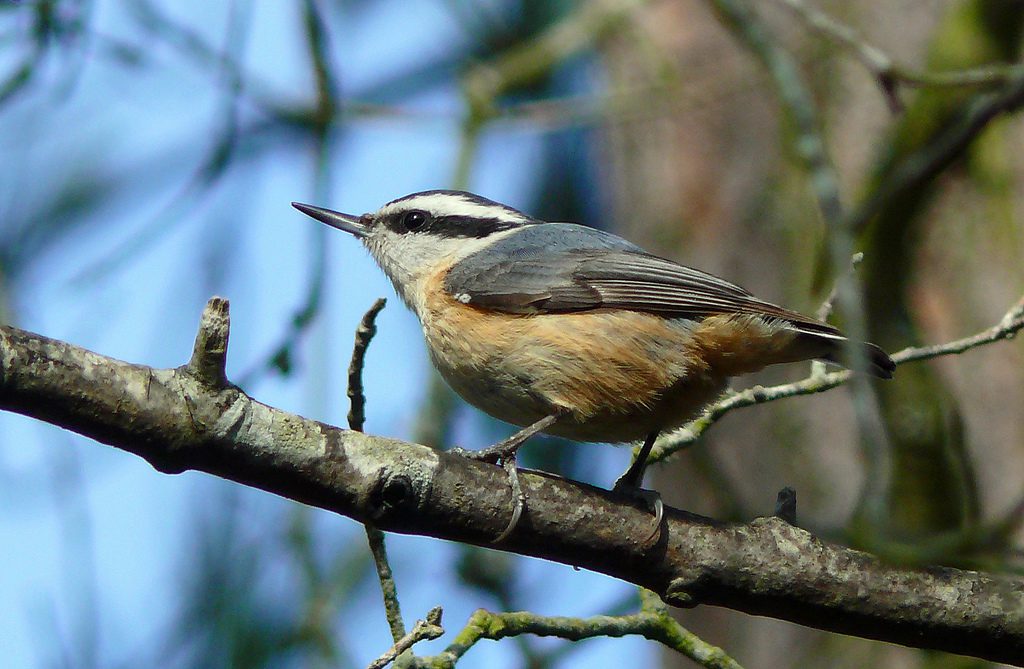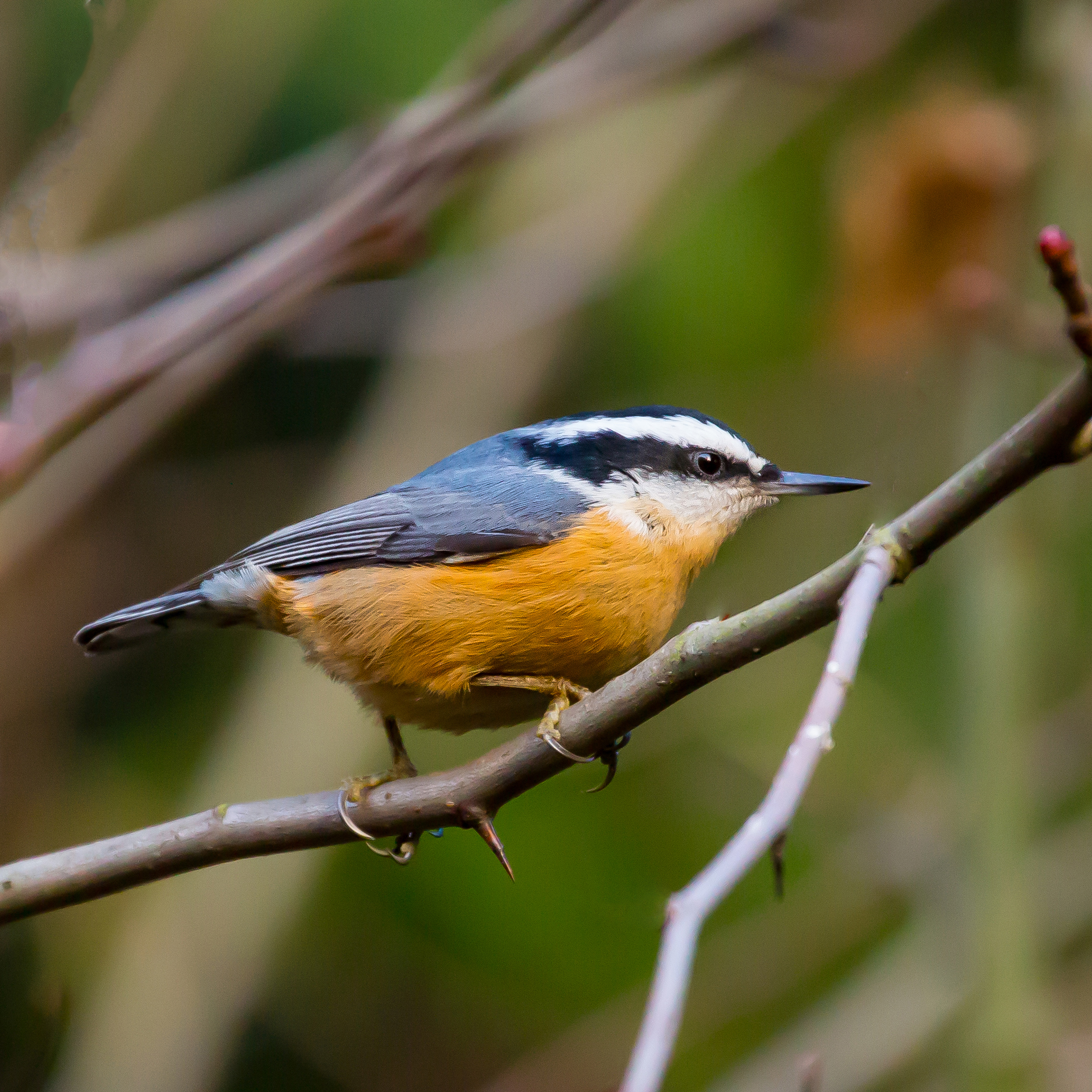In the world of conifer woods, a lively and vibrant community exists, painted with the colors of the Red-breasted Nuthatches. These small birds find solace and make their homes in the northern and western parts of the United States. With their distinctive red chests and charismatic personalities, Red-breasted Nuthatches capture the hearts of bird enthusiasts and backyard feeders alike. From May to July, the nesting season begins, showcasing courtship and pair bonding behaviors. Typically, it is the females who take charge in nest-building, creating cozy cavities within dead branches of trees. With moss, grass, feathers, and other plant materials, they line their nests, while sometimes stealing some nesting material from others. With a strong territorial streak in the nest-building period, they fiercely chase away other nuthatches and hole-nesting birds. The process of nest-building itself can take up to 18 days to 1-8 weeks, ensuring a safe haven for their precious eggs. These charming creatures bring life and joy to the conifer woods and may grace our own backyards with their presence.

Red-breasted Nuthatches: Living in Conifer Woods
Red-breasted Nuthatches are charming little birds that can be found in the northern and western parts of the United States. These small birds primarily make their homes in conifer woods, where they feel most comfortable and thrive. Let’s take a closer look at their physical characteristics, habitat and distribution, migration patterns, nesting behavior, and more.
Physical Characteristics
Red-breasted Nuthatches are small in size, measuring around 4.5 inches in length. They are known for their vibrant coloration, featuring a rusty-red breast and a bluish-gray back. The top of their head is black, and they have a distinct black eye stripe that stands out against their white face. Their beaks are short and thin, perfectly suited for their preferred diet of insects and seeds. Overall, their unique combination of colors makes them easy to identify.
Habitat and Distribution
As mentioned earlier, Red-breasted Nuthatches primarily live in conifer woods. They prefer the dense foliage of coniferous trees, such as spruces and pines, which provide them with ample cover and food sources. The northern and western parts of the United States offer the ideal habitat for these birds, where conifer forests are abundant. They can be found in states like Alaska, Washington, Montana, and Oregon, among others.
Migration Patterns
While Red-breasted Nuthatches are resident birds in their preferred conifer woods, some individuals do migrate south during the winter months. This migration allows them to find new food sources as the colder weather limits their foraging options. Interestingly, during the winter, these birds may also make appearances at backyard feeders, where they can be observed up close by bird enthusiasts.

Nesting Behavior
Breeding season for Red-breasted Nuthatches typically occurs from May to July, although the exact timing can vary depending on the location. During this time, courtship and pair bonding behaviors begin, as the birds prepare to build their nests and start a new family. Females take on the primary responsibility of nest-building, while males assist by bringing food and taking care of their partner.
Nest Construction
Red-breasted Nuthatches have a unique approach to nest construction. They prefer to excavate their own nests in dead branches of trees, particularly in mature conifer forests or near aspen trees. These resourceful birds build their nests at varying heights, typically ranging from 5 to 40 feet above the ground. The average nest height is around 15 feet.
To construct their nests, Red-breasted Nuthatches gather materials such as moss, grass, bark, feathers, and other plant matter. They intricately weave these materials together to form a cozy and secure nest for their eggs. It is worth noting that these birds are not opposed to using stolen nesting material from other birds, adding an interesting twist to their nest-building process.

Territorial Behavior
During the nest-building period, Red-breasted Nuthatches display territorial behavior. They fiercely protect their chosen nest site and will chase away other nuthatches and hole-nesting birds that may pose a threat. These little birds are known to be quite vigilant and determined when it comes to safeguarding their nests, ensuring the safety of their offspring.
Nest-Building Period
The process of building a nest can take anywhere from 18 days to 1-8 weeks for Red-breasted Nuthatches. The duration may vary depending on various factors, including the availability of nesting materials, suitable nest sites, and the overall efficiency of the nesting pair. These birds meticulously construct their nests, taking care to make them sturdy and well-insulated for their future nestlings.

Choosing Nest Sites
Red-breasted Nuthatches have specific preferences when it comes to choosing nest sites. They have a strong affinity for conifer forests, which provide them with the ideal environment for nesting and rearing their young. Additionally, these birds tend to select nest sites in proximity to aspen trees, which may serve as an additional food source or offer further protection for their nests. Dead trees and branches are also highly valued by Red-breasted Nuthatches, as they often utilize them for tunneling or cavity-nesting.
Artificial Nest Boxes
For those interested in attracting Red-breasted Nuthatches to nest in their backyards, the use of artificial nest boxes can be a helpful option. These nest boxes need to be designed with specific dimensions and entry hole sizes to accommodate the needs of these birds. By providing suitable nesting sites, individuals can encourage these charming birds to visit and potentially build their nests closer to home.

Breeding and Reproduction
Red-breasted Nuthatches engage in breeding and reproduction during the nesting season. The female lays a clutch of 2-8 eggs, with an average of 5-6 being typical. The eggs are usually laid between April and June, depending on factors such as location and weather conditions. Once the eggs are laid, the incubation period begins.
Egg Laying
The female Red-breasted Nuthatch primarily takes on the responsibility of incubating the eggs. During this time, the male assists by bringing food to the nest to nourish his mate. The incubation period for Red-breasted Nuthatches lasts approximately 12-13 days, during which the eggs are kept warm and protected until they hatch into nestlings.
Incubation and Nestling Period
After the incubation period, the eggs hatch, and the young birds, called nestlings, emerge. Both parents play an active role in caring for the nestlings, diligently providing them with food. The primary diet of nestling Red-breasted Nuthatches consists of insects and spiders, which the parents skillfully procure to feed their hungry offspring. This period is crucial for the development and growth of the nestlings.
Fledgling Stage
Once the nestlings are sufficiently grown and have gained strength, they enter the fledgling stage. This stage marks the transition from being inside the nest cavity to exploring the outside world. Fledglings are observed outside the nest, accompanied by their parents, from June to July. This period allows the young birds to gain experience and develop their abilities further before they become independent.
Parental Care
Throughout the nesting season, both parents exhibit exceptional care for their offspring. From incubation to feeding the nestlings, the parents work tirelessly to ensure the survival and well-being of their young. This level of parental care is crucial to the successful growth and development of the Red-breasted Nuthatch population.
In conclusion, Red-breasted Nuthatches are fascinating birds that thrive in conifer woods. Their distinct physical characteristics, habitat preferences, nesting behavior, and migration patterns contribute to their unique and charming presence in the avian world. By understanding and appreciating these aspects of their lives, bird enthusiasts can develop a deeper connection with these delightful little birds.
Leave a Reply